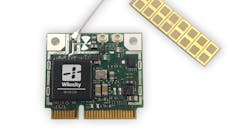Reference Design Features IEEE 802.11ac and 802.11ad
To bring increased capacity, range, and efficiency to wireless-local-area networks (WLANs), the IEEE has created two standards: 802.11ac and 802.11ad. The latter, which was just recently ratified, enables multi-gigabit networking, data syncing, and video and audio streaming while maintaining its wireless bus-extension-docking capabilities. With many firms looking to leverage both of these standards, Qualcomm Atheros, Inc. and Wilocity have produced a tri-band reference design that combines IEEE 802.11ac and 802.11ad wireless capabilities on one module (see photo).
By merging Qualcomm VIVE 802.11ac WiFi and Wilocity 802.11ad WiGig wireless technologies, the reference design allows consumers to connect to 60-GHz-enabled devices, docks, displays, and storage at multi-gigabit speeds. At the same time, they can maintain their enterprise-wide or whole-home coverage with 2.4/5-GHz WiFi. By integrating a solution that combines whole home, gigabit-class WiFi with in-room, multi-gigabit connectivity into their devices, equipment manufacturers will benefit from increased speed, reliability, and range.
At the heart of this reference board is a tri-band wireless networking card, which leverages the new Qualcomm VIVE 802.11ac combined with IEEE 802.11ad technology. That card will be available in two options: the QCA9006NFC next-generation form factor (NGFF) and the QCA9006WBD half-mini-card (HMC) specification.

